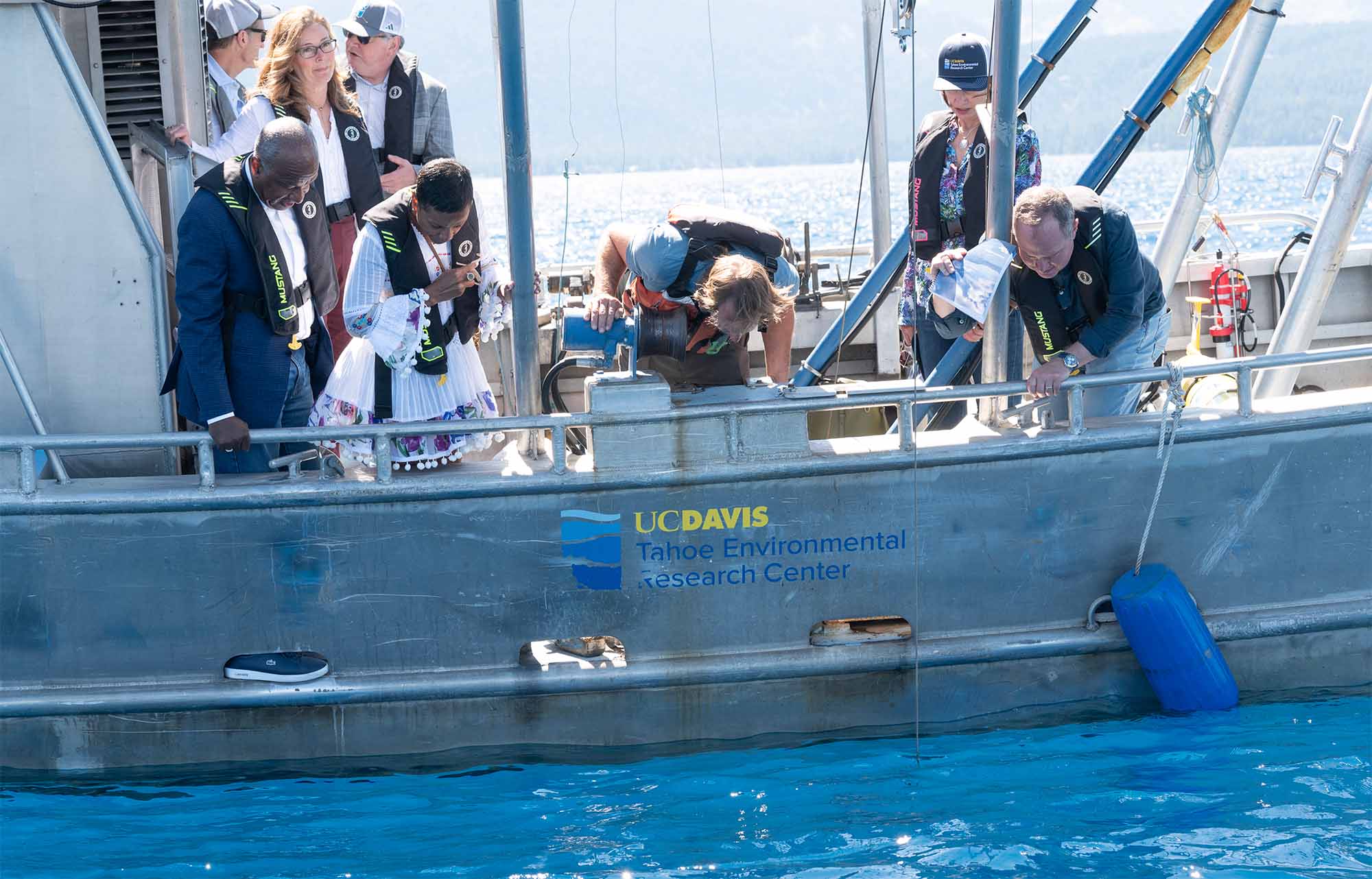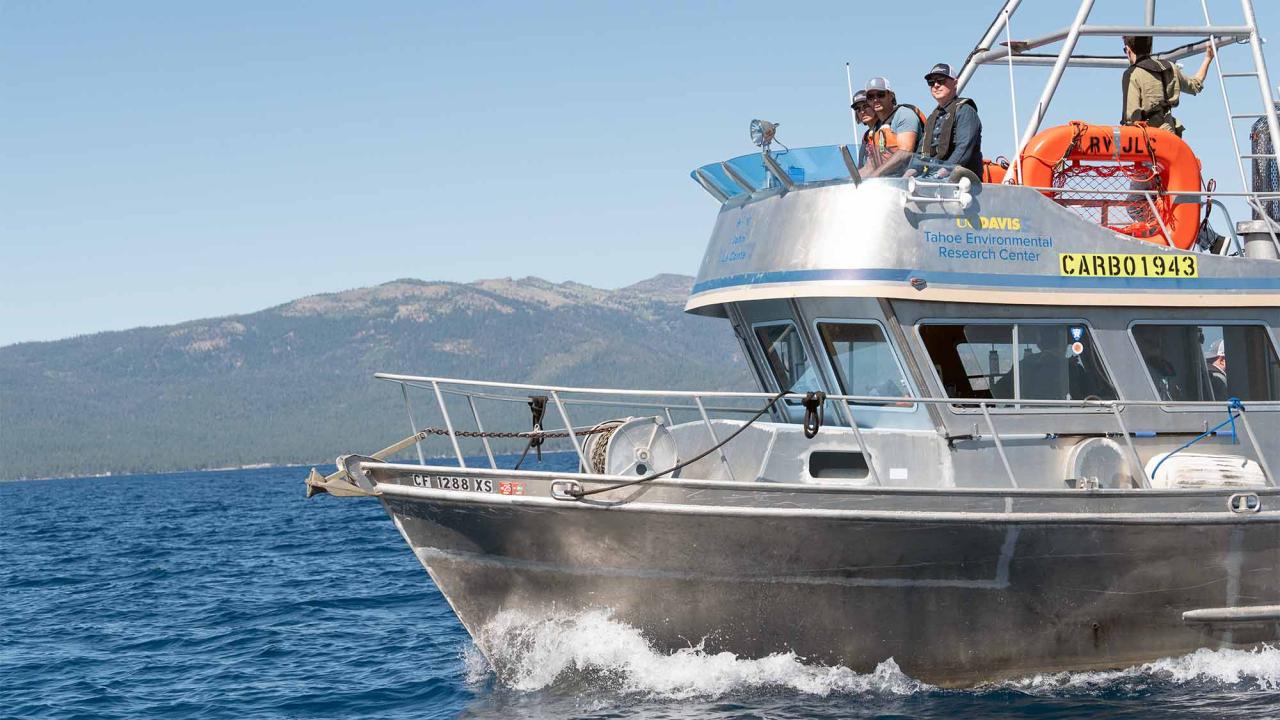Sen. Adam Schiff (D-California) peered into the crystal-blue depths of Lake Tahoe as a crew from the Tahoe Environmental Research Center, or TERC, lowered a white disk into the water. “I can see about 63 feet,” declared the first-term senator.
It was Schiff’s maiden voyage aboard the research vessel John LeConte, a floating laboratory operated by UC Davis, through the research center known as TERC. Since the LeConte, named after a 19th century UC physicist leader, was built in 1976, the vessel has hosted countless students, researchers, elected leaders including former President Bill Clinton and Vice President Al Gore, among others.
While the boat still functions as a laboratory — the workhorse of TERC’s three vessels — these days it’s approaching museum status. TERC officials say the LeConte is nearing the end of its usable life, with its hull degraded to the point where it could fail within two or three years. Some of the boat’s accessories have become rickety and require frequent repairs, such as the pulley-and-cable system that lowered the white circle, known as a Secchi disk, into the water. The diesel-powered vessel itself is slow, which is fine for a pleasure cruise but not for researchers monitoring conditions throughout the 191-square-mile lake straddling California and Nevada in the Sierra Nevada.

The boat is outfitted with instrumentation including an electric glider, on loan from the National Oceanic and Atmospheric Administration, that resembles a yellow torpedo and is equipped with sensors to monitor conditions as it silently glides underwater. There’s a multitude of sensors that descend hundreds of meters under the surface taking measurements, and nets to trawl for zooplankton, a key component of the aquatic ecosystem, and bring them to the surface for observation. Schiff and others viewed the zooplankton undulating in clear plastic containers filled with freshly sampled lake water.
The senator’s visit on Aug. 5, served two purposes: to better acquaint the senator, who represented parts of Southern California in the House before assuming his statewide seat in December 2024, with the Tahoe ecosystem and UC Davis’ role in monitoring it, and to give him a close-up view of the vessel. The outing came the day before the 29th annual Tahoe Summit, which brings together leaders from California and Nevada to discuss the state of Lake Tahoe.
Schiff had previously requested a $1.95 million earmark to replace the LeConte, but the proposal did not make it through the appropriations process in late July. UC Davis officials hope for another shot next year.
Despite its age, the boat plays an essential role in the health of Lake Tahoe, noted Stephanie Hampton, an aquatic ecologist who joined TERC as its director earlier this year.
TERC researchers use the LeConte to monitor the presence of invasive species, the quantity of plankton (a barometer of lake health and a food source for fish), dissolved oxygen levels, salinity, water turbulence, the growth of algae, the clarity of and temperature of the water, and many other variables that collectively inform policymaking in the Tahoe Basin and beyond. Lately, TERC researchers have been collaborating with research partners at the Desert Research Institute to analyze how microplastics have been entering Lake Tahoe through the air.
Chancellor Gary S. May, who joined Schiff, Vice Chancellor for Research Simon Atkinson and TERC leaders and researchers on the demonstration tour, noted UC Davis’ longstanding commitment to Lake Tahoe, dating back to 1958.
“We think it’s important for science to inform policy,” May said. “We’re providing the science and the data to make good policy.”
After stepping off the research vessel in Tahoe City, Schiff noted that UC Davis’ comprehensive research of Lake Tahoe — which he called an “ecological treasure” — was essential to maintaining the health and clarity of the lake, as well as the ecosystems that depend on it.
“Even with all of the best efforts going on, we’re still seeing a negative trend with the clarity of the water,” he said. “We’re hoping to bend the curve and make it better.”
Media Resources
Media Contact
- James Nash, UC Davis News and Media Relations, 530-219-0943, jnash@ucdavis.edu
